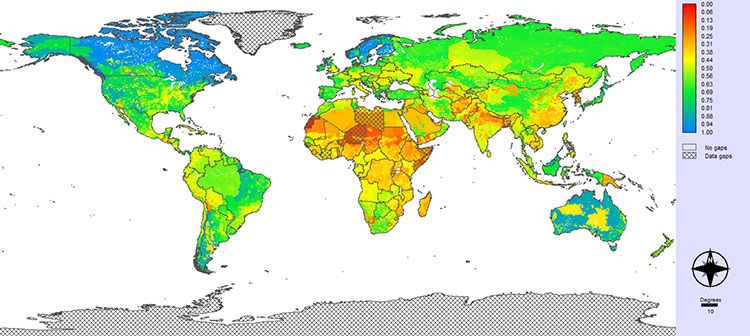New Index Offers Snapshot of Global Water Security
Published on by Water Network Research, Official research team of The Water Network in Academic
To help track progress towards sustainable development goal, researchers have developed a new index for global water security.

Aggregated global water security index, calculated using the aggregation of water availability, accessibility, safety and quality, and management indices. The value '0–1' (with the continuous colour 'red to blue') represents 'low to high' security. The shaded areas identify countries with data gaps. Image credit ERL.
The index is based on a spatial analysis framework that encompasses multiple criteria relating to water security. The major inputs include availability, accessibility to services, safety and quality, and management.
Data for each of the indicators were collected from a variety of sources, ranging from modelling outputs to previous studies. "As the indicator values have different units of measurement, these were normalized between a scale of 0 and 1," Animesh Gain of the GFZ German Research Centre for Geosciences told environmentalresearchweb. "We then aggregated the indicators into security criteria, which in turn are further aggregated to produce the final outcome."
Also contributing to the study were Carlo Giupponi of the Venice Centre for Climate Studies, Italy, and Yoshihide Wada, whose affiliations include the NASA Goddard Institute for Space Studies, US.
The group’s work provides a global snapshot of water security, incorporating details such as aridity, drought and groundwater depletion. As the researchers note in their paper, combinations of high water demand, population (and economic) growth, and arid environments exacerbate the imbalance between needs and available resources.
Plotting the index on a world map highlights water-availability issues in India, China and parts of the US and Africa. The results also show that Bangladesh, India, Brazil and China face problems in terms of flood risk, impaired water quality, governance and transboundary management.
There are also some more encouraging takeaways. Comparing water security with water scarcity paints a positive picture for Australia, thanks in part to good water management. And there’s scope to build on the group’s framework.
One of the biggest difficulties facing the team was sourcing comparable global raw data with adequate spatial detail, particularly for locations in Africa and Asia.
"Country-level averaging and aggregation hide the variability of physical and socio-economic phenomena," said Gain. "Looking ahead, remotely sensed data provided by satellites are likely to play an increasing role in delivering the spatial and temporal information that is required."
Read and download full study 'Measuring Global Water Security Towards Sustainable Development Goals' here
Source: Environmental Research Web
Media
Taxonomy
- Water Security
- Water Access
- Research
- Scarcity
- Data Management
- Integrated Water Management
- Water Supply
- Consumption
- Integrated Infrastructure
- Water Software
- Integrated Water Resources Management (IWRM)